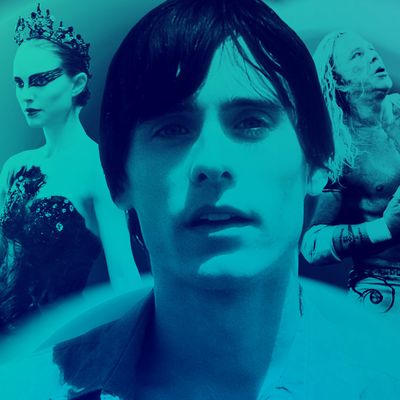
Brooklyn native Darren Aronofsky’s work is brilliant and vexing. Few filmmakers have his talent for inducing subjective states, hurtling past the blood-brain barrier to create fever dreams in which you can’t tell what’s real and what’s fantasy — or if, when you come down to it, there’s a meaningful difference in a world in which reality is subjective. But he doesn’t develop or vary his premises. His dramatic strategy is escalation, to the point of audience cruelty.
There’s less of a spread between Aronofsky’s films than most directors’, chiefly because they have so much in common, and because all but two work on their own terms. It’s those terms that tend to be the problem. He has amazing filmmaking chops, though. While he has yet to make his masterpiece, there might well be miracles to come.
7. Mother!
Astonishing — but only because it’s hard to believe that Aronofsky could be both so empty-headed and so bludgeoning. Jennifer Lawrence is “mother,” who tries to create a country paradise for her writer husband (Javier Bardem, identified as Him) but is increasingly unnerved, alienated, and assaulted by hordes of invaders. The early scenes feel like a theater piece tricked out with Gothic horror effects and a big dose of Polanski’s Rosemary’s Baby. But the surrealistic last act is like the Marx Brothers’ stateroom without the laughs. Aronofsky seems to be trying to do an auto-critique — to dramatize an artist’s sadism toward his characters and performers. But it’s self-aggrandizing instead of self-analytical, and turns Lawrence — until now a blessedly un-masochistic actress — into a doll for a director to torture.
6. Noah
Nowhere near as bad as you’ve heard, but certainly Aronofsky’s least personal work. The studio demanded melodrama to go with Old Testament spectacle, which means Russell Crowe’s cranky Noah (who at one point tries to slaughter his family) does battle with a murderous stowaway who’s a descendant of Cain. Another multiplex-friendly addition is the group of fallen angels who live as boulders but can assemble themselves into primordial Transformers. The film is not irreverent, but religious right-wingers were incensed that God’s chief reason for the flood was that mankind was despoiling of the natural world. God as a tree-hugger? Blasphemy!
5. The Fountain
Aronofsky is mad about mandalas and golden orbs in this loony-tunes Buddhist time-travel extravaganza, starring Hugh Jackman as a man at war with death in three evolutionary phases, each intercut for maximum mystification. In the main, modern thread, he’s a scientist who labors to cure cancer before his precious wife (Rachel Weisz) gives up the ghost. He’s also a bald guy in the lotus position floating in a bubble. The score by Clint Mansell is what you’d hear if your massage therapist wanted to induce a stroke. Aronofsky lost his lead and part of his budget right before shooting, which might account for the narrative elisions. I know people who think this is one of the most romantic films ever made and I envy their belief.
4. Black Swan
Aronofsky’s big hit, which won an Oscar for Natalie Portman. Although she’s unconvincing as a prima ballerina, her head looks good in the shots when it’s affixed (via computer) to a real dancer’s body. And does she ever go through hell. Her character wants to dance the Swan Queen in Tchaikovsky’s Swan Lake, but her company’s artistic director maintains she’s only suited for the white, innocent half the double role. For the dark, demonic twin, he says, she’s too childlike, repressed. Like a Method acting guru, he exhorts her to lose control, surrender to her sexuality, and icky, feathery things sprout from her flesh as she turns into a Bad Girl. It’s a virtuosic piece of filmmaking, a tour de force — and a camp classic, like Showgirls remade by Roman Polanski.
3. Requiem for a Dream
It’s understandable that a director with an instinct for injecting his hallucinatory images into your bloodstream would want to tackle a melodrama of addiction, and without its last 20 minutes or so, this would be Aronofsky’s best film. He has devised a progression of trip motifs — jumpy, slow- and fast-motion, alternately slurry and brusque. You know in your guts why humans prefer this mode of being over the flatness of the real world. It’s a vision of a whole class of people — a group played by Jared Leto, Jennifer Connelly, Marlon Wayans, and Ellen Burstyn — festering in its own capitalism-induced fantasies. But how can you make the inevitable crash-and-burn enlightening instead of just predictably torturous? Don’t ask Aronofsky. The movie becomes increasingly unwatchable — not just bleak but punishing, as if the director wants to fry the audience’s circuits.
2. Pi
Aronofsky’s remarkable first feature is still near the top. Sean Gullette plays the man obsessed with finding the origin of life, which centers on the title mathematical constant. That obsession is right there — organically — in the filmmaking, in the fractured montage and the flurries of talismanic signs. The other characters — a fanatical Hasidic Kabalistic sect and some equally determined Wall Street analysts — both mirror and feed that drive, so it’s as if the whole world is swirling around this poor guy’s head.
1. The Wrestler
Mickey Rourke plays the tragic hero, Randy “the Ram” Robinson, an aging pro-wrestler with nothing real in his life but Grand Guignol orgies in which men in mythically garish costumes twist and pummel each other before slobbering crowds. We see the world through Randy’s swimming perceptions, sharing his masochistic joy even as we cringe and hide our eyes. I’ve heard the theory that The Wrestler has more variety and interest than Aronofsky’s other works because he met his match in Rourke, who’s basically undirectable and generated a nightmarish but ultimately productive tension on the set. For once, the control freak Aronofsky stood by and watched his protagonist’s agony instead of generating it.


